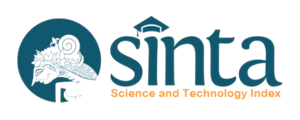INNOVATIVE TEACHING STRATEGIES FOR ENHANCING THE USE OF DESIGNATED ENGLISH PHRASES
(1) University of Venda, South Africa
(2) Institut Agama Islam Negeri Palangka Raya, Indonesia
(*) Corresponding Author
Abstract
Keywords
Full Text:
PDFReferences
Abdullah, A. T. H., Azmi, M. N. L., Hassan, I., Atek, E. S. E., & Jusoh, Z. (2022). Investigation into common errors in English writing among non-academic staff at a Malaysian Public University. Arab World English Journal, 12(4), 446-461. https://dx.doi.org/10.24093/awej/vol12no4.29
Abuhamda, E., Bsharat, T. R. A., & Ismail, I. A. (2021). Understanding quantitative and qualitative research methods: A theoretical perspective of young researchers. International Journal of Research, 8(2),71-87. https://dx.doi.org/10.2501/ijmr-201-5-070
Ahmed, S. A. S. (2023). A meta-analysis on publications for lecturers’ perception of blended learning in higher education from 2020-2022. European Journal of Education Studies, 10(8), 215-228. https://dx.doi.org/10.46827/ejes.v10i8.4923
Al-Qaddoumi, K., & Ageli, N. (2023). Redundancy and ellipsis in the translation into English of selected Arabic media texts. International Journal of Translation and Interpretation Studies, 3(2),16-23. https://doi.org/10.32996/ijtis.2023.3.2.2
Anis, N. I. M. (2021). The effect of shadowing technique on speaking skills: A pre-experimental study at Eighth-grade students’ of SMP N 26 Makassar [Master's thesis, Universitas Muhammadiyah Makassar].
Babbie, E., Wagner, W. E., & Zaino, J. (2022). Adventures in social research: Data analysis using IBM SPSS statistics. Thousand Oaks, CA: Sage Publications.
Bizami, N. A., Tasir, Z., & Kew, S. N. (2023). Innovative pedagogical principles and technological tools capabilities for immersive blended learning: A systematic literature review. Education and Information Technologies, 28(2), 1373-1425. https://doi.org/10.1007/s10639-022-11243-w
Brysbaert, M., Keuleers, E., & Mandera, P. (2021). Which words do English non-native speakers know? New supernational levels based on yes/no decision. Second Language Research, 37(2), 207-231. https://doi.org/10.1177/0267658320934526
de la Torre, L. (2024). Re: What is the minimum number of respondents for a pilot study questionnaire? University of Benghazi. Researchgate. Retrieved from https://www.researchgate.net/post/What_is_the_minimum_number_of_respondents_for_a_pilot_study_questionnaire/6642e5e7739947dc9f0145f6/citation/download
Do‘smurod, Q, E. M. (2023). Word formation of part of speech noun affixation and similarities and differences in English and Uzbek languages. Golden Brain, 1(10), 440-446. https://doi.org/10.5281/zenodo.7833637
Do-Thi, P., & Do, I. (2022). The full process in modeling and quantitative methods by using SPSS. In S. A. Abdul Karim (Ed.), Intelligent systems modeling and simulation II: Studies in systems, decision, and control (pp. 579-626). Cham: Springer. https://doi.org/10.1007/978-3-031-04028-3_38
Dsouza, J. (2022), The study of the impact of shadowing exercise in reducing speaking anxiety among college students. Research Journal of English Language and Literature (RJELAL), 10(3), 106-110. https://doi.org/10.33329/rjela.10.3.105
Elfseyie, M. (2024). What is the minimum number of respondents for a pilot study questionnaire?. Researchgate. Retrieved from https://www.researchgate.net/post/What_is_the_minimum_number_of_respondents_for_a_pilot_study_questionnaire/6642e5e7739947dc9f0145f6/citation/download
Foreshew, A., & Al‐Jawad, M. (2022). An intersectional participatory action research approach to explore and address class elitism in medical education. Medical Education, 56(11), 1077-1085. https://doi.org/10.1111/medu.14857
Greenspon, R., & Volungevičienė, A. (2023). How can a technology-enhanced learning environment support learning-oriented assessment in higher education? Pedagogika, 150(2), 58-74. https://doi.org/10.15823/p.2023.150.4
Guo, W., & Jiang, Z. (2022). Data analysis deep learning research on spatiotemporal preposition construction network. Wireless Communications and Mobile Computing, 2022(1), 1-11. https://doi.org/10.1155/2022/9416747
Hayati, S., Armansah, Y., & Ismail, S. F. A. B. (2021). Teachers experiences on blended learning: A case study of a group of secondary school teachers in Malaysia and Indonesia. Jurnal Kependidikan: Jurnal Hasil Penelitian dan Kajian Kepustakaan di Bidang Pendidikan, Pengajaran dan Pembelajaran, 7(4), 767-777. https://doi.org/10.33394/jk.v7i4.4102
Hendren, K., Newcomer, K., Pandey, S. K., Smith, M., & Sumner, N. (2023). How qualitative research methods can be leveraged to strengthen mixed methods research in public policy and public administration? Public Administration Review, 83(3), 468-485. https://doi.org/10.1111/puar.13528
Hidayah, N. (2023). Pengaruh model pembelajaran jigsaw pada mata pelajaran IPA untuk meningkatkan hasil belajar kognitif siswa kelas VIII SMP Negeri 7 Halmahera Utara [The influence of the jigsaw learning model on science subjects to improve cognitive learning outcomes of class VIII students at SMP Negeri 7 North Halmahera]. ACTION: Jurnal Inovasi Penelitian Tindakan Kelas dan Sekolah, 3(1), 42-47. https://doi.org/10.51878/action.v3i1.1983
Kholmamatovna, B. L. (2023). Some features of teaching speaking in English as a foreign language. Finland International Scientific Journal of Education, Social Science & Humanities, 11(2), 823-831. https://doi.org/10.5281/zenodo.7678653
Lawson, M. J., Van Deur, P., Scott, W., Stephenson, H., Kang, S., Wyra, M., & Graham, L. (2023). The levels of cognitive engagement of lesson tasks designed by teacher education students and their use of knowledge of self-regulated learning in explanations for task design. Teaching and Teacher Education, 125, 104043. https://doi.org/10.1016/j.tate.2023.104043
Leclercq, B., & Depraetere, I. (2022). Making meaning with being able to: Modality and actualisation. English Language & Linguistics, 26(1), 27-48. https://doi.org/10.1017/S1360674320000489
Morita‐Mullaney, T., Gao, F., & Zhang, R. (2023). When literacy ate language: An analysis of a research‐based literacy intervention for designated English Learners. TESOL Journal, 14(3), 1-20. https://doi.org/10.1002/tesj.718
Otaraly, S., Alikey, A., Sabyrbek, Z., & Poteliūnienė, S. (2023). Enhancing university students’ functional fitness by applying health programs based on individual student heart rate monitoring data. Pedagogika, 150(2), 38-57. https://doi.org/10.15823/p.2023.150.3
Paragae, I. P. N. S. (2023). Innovative teaching strategies in teaching English as a foreign language. English Teaching and Linguistics Journal (ETLiJ), 4(1), 1-9. https://doi.org/10.30596/etlij.v4i1.12990
Pasaribu, S. P. Y., Hutasoit, R. D., & Sihombing, Y. N. (2022). Enhancing students’ vocabulary by using flashcard media via Google Classroom during COVID-19. Edukatif: Jurnal Ilmu Pendidikan, 4(1), 227-232. https://doi.org/10.31004/edukatif.v4i1.1808
Rai, M. (2023). Is the phrase 'according to me' correct? Linkedin Corporation. Retrieved from https://www.linkedin.com/pulse/phrase-according-me-correct-monika-rai/
Riski, J., Ahola, A., Skriko, T., & Björk, T. (2023). Low-cycle fatigue in ultra-high-strength steel welded joints in the as-welded and post-weld-treated conditions. Advances in Structural Engineering, 26(12) 2292-2306. https://doi.org/10.1177/13694332231178977
Rivera, M., Paolieri, D., Iniesta, A., Pérez, A. I., & Bajo, T. (2023). Second language acquisition of grammatical rules: The effects of learning condition, rule difficulty, and executive function. Bilingualism: Language and Cognition, 26(4), 639-652. https://doi.org/10.1017/S1366728922000815
Safitri, R., Putri, D. E., Efendi, E., Veni, V., Vratiwi, S., Ekaputri, Y. N., & Pratama, M. I. L. (2023). An error analysis in arranging the structure of noun phrases made by the eleventh-grade students of SMA N 2 Muaro Jambi. Journal on Education, 6(1), 3858-3867. https://doi.org/10.31004/joe.v6i1.3496
Schaefer, J. L. (2023). By teaching, we learn. Notre Dame Learning. Retrieved from https://learning.nd.edu/news/by-teaching-we-learn/
Schneider, N., Wessels, A. & Pilz, M. (2023). Theory and Practice of Teaching and Learning in the Classroom – Lessons from Indian Industrial Training Institutes. Vocations and Learning, 16, 99–120. https://doi.org/10.1007/s12186-022-09305-8
Thompson, S. (2023). Innovative teaching strategies. Kaltura. Retrieved from https://corp.kaltura.com/blog/innovative-teaching-strategies/
Tursunovich, R.I. (2023). Development of communicative competence in teaching foreign language for professional purposes. Proceedings of International Conference on Scientific Research in Natural and Social Sciences, 2(1), 26-33.
Ulwiyah, S. A., Ayuni, R. T., & Wahyuni, A. (2023). The use of SPSS in mathematics education: Biblioshiny & bibliometric analysis (1997-2023). Journal of Technology Global, 1(01), 26-33.
Wright, S. (2024). Is the phrase “according to me” correct? Quora. Retrieved from https://www.quora.com/Is-the-phrase-according-to-me-correct
Yang, Y. (2022). The investigation of redundancy errors in the writing of Chinese English learners with different proficiency. Proceedings of the 2021 International Conference on Education, Language and Art (ICELA 2021), 139-146. https://doi.org/10.2991/assehr.k.220131.025
Zagórska, A. (2022). Defining collocations for LSP lexicography. Kwartalnik Neofilologiczny, LXIX(I), 90-103. https://doi.org/10.24425/kn.2022.141252
DOI: https://doi.org/10.24071/llt.v27i2.9436
Refbacks
- There are currently no refbacks.
Copyright (c) 2024 FARISANI THOMAS NEPHAWE, M. Zaini Miftah

This work is licensed under a Creative Commons Attribution-ShareAlike 4.0 International License.
LLT Journal: A Journal on Language and Language Teaching Sinta 1 Certificate
.jpg)

This work is licensed under CC BY-SA.
Creative Commons Attribution-ShareAlike 4.0 International License


.png)

















